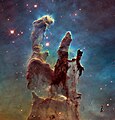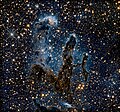Fitxategi:Eagle Nebula - GPN-2000-000987.jpg

Aurreikuspen honen neurria: 606 × 600 pixel. Bestelako bereizmenak: 242 × 240 pixel | 485 × 480 pixel | 776 × 768 pixel | 1.035 × 1.024 pixel | 1.944 × 1.924 pixel.
Bereizmen handikoa ((1.944 × 1.924 pixel, fitxategiaren tamaina: 1,18 MB, MIME mota: image/jpeg))
Fitxategiaren historia
Data/orduan klik egin fitxategiak orduan zuen itxura ikusteko.
| Data/Ordua | Iruditxoa | Neurriak | Erabiltzailea | Iruzkina | |
|---|---|---|---|---|---|
| oraingoa | 02:30, 3 urria 2012 |  | 1.944 × 1.924 (1,18 MB) | Ras67 | losslessly cropped with Jpegcrop |
| 03:17, 9 apirila 2009 |  | 1.993 × 1.973 (1,45 MB) | BotMultichillT | {{Information |Description={{en|1=These eerie, dark pillar-like structures are columns of cool interstellar hydrogen gas and dust that are also incubators for new stars. The pillars protrude from the interior wall of a dark molecular cloud like stalagmite |
Irudira dakarten loturak
Hurrengo orrialdeek dute fitxategi honetarako lotura:
Fitxategiaren erabilera orokorra
Hurrengo beste wikiek fitxategi hau darabilte:
- ar.wikipedia.org proiektuan duen erabilera
- en.wikipedia.org proiektuan duen erabilera
- fa.wikipedia.org proiektuan duen erabilera
- hu.wikipedia.org proiektuan duen erabilera
- ka.wikipedia.org proiektuan duen erabilera
- kw.wikipedia.org proiektuan duen erabilera
- zh.wikipedia.org proiektuan duen erabilera







